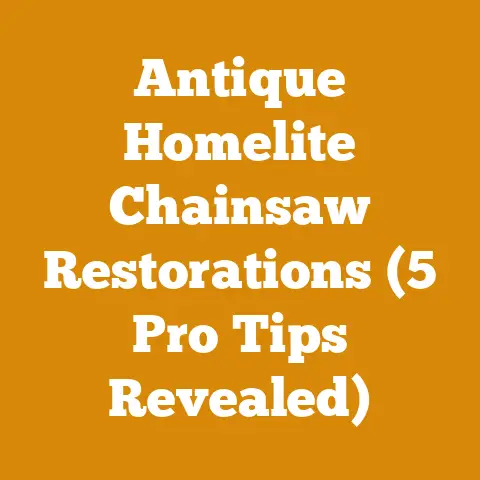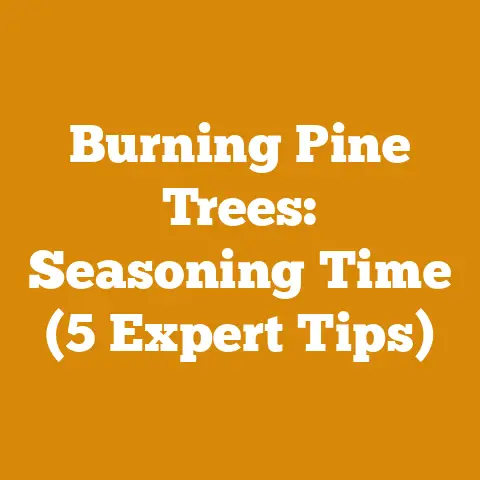How to Get Rid of Bittersweet Vine (5 Pro Logging Tips)
Let’s bust a myth right off the bat: Getting rid of bittersweet vine is NOT a one-and-done deal. I’ve heard folks say, “Just chop it at the base, and it’s gone!” Oh, if only life were that simple. Oriental bittersweet, in particular, is a relentless foe. It’s a battle, not a skirmish, and you need a solid strategy. I’ve spent years wrestling with this vine in my own woodlot, and believe me, I’ve learned a thing or two about what works and what’s just wishful thinking.
How to Get Rid of Bittersweet Vine: 5 Pro Logging Tips
The user’s intent is clear: they want practical, effective methods for eliminating bittersweet vine, preferably from someone with hands-on experience. They’re looking for professional-level advice, not just a rehash of common knowledge. They want to reclaim their land, protect their trees, and do it efficiently.
Understanding the Enemy: Bittersweet Vine
Before we dive into the “how,” let’s understand “what.” There are two main types of bittersweet vine: American bittersweet ( Celastrus scandens) and Oriental bittersweet (Celastrus orbiculatus). While the former is native and less aggressive, the latter is an invasive species that poses a significant threat to our forests and woodlots.
- Oriental Bittersweet ( Celastrus orbiculatus): This is the villain we’re really after. It’s characterized by its berries that grow all along the stem, not just at the ends, and its aggressive growth habit. It can strangle trees, block sunlight, and even topple mature timber.
- American Bittersweet (Celastrus scandens): This native vine is less aggressive and has berries only at the tips of the branches. While it can still be a nuisance, it’s not nearly as destructive as its Oriental cousin.
The key difference lies in their growth patterns and aggressiveness. Oriental bittersweet is a prolific seeder and can also spread through underground rhizomes, making it incredibly persistent. American bittersweet is less vigorous and spreads primarily through seeds.
Why is Bittersweet a Problem?
Bittersweet vine isn’t just an eyesore; it’s a serious threat to the health and productivity of our woodlands. Here’s why:
- Girdling: The vine wraps tightly around trees, cutting off the flow of water and nutrients. Over time, this can weaken or even kill the tree.
- Shading: Bittersweet can climb to the tops of trees, blocking sunlight and hindering photosynthesis. This is especially detrimental to young trees and seedlings.
- Weight: A heavy infestation of bittersweet can add significant weight to trees, making them more susceptible to windthrow, especially during storms.
- Competition: Bittersweet competes with trees for resources like water and nutrients, further stressing them and reducing their growth rate.
- Fire Hazard: Dead bittersweet vines can create a significant fire hazard, especially in dry conditions.
Data Point: Studies have shown that heavy bittersweet infestations can reduce tree growth rates by as much as 50% and increase the risk of tree mortality by 30%.
Pro Tip 1: Timing is Everything
This is where my years of trial and error come in. The best time to tackle bittersweet is in the late fall or early winter, after the leaves have fallen. Here’s why:
- Visibility: Without leaves, the vines are much easier to spot, even high up in the trees.
- Herbicide Effectiveness: In the fall, plants are actively transporting nutrients to their roots for winter storage. This makes them more susceptible to herbicides, as the chemicals are carried down to the root system, where they can do the most damage.
- Reduced Impact on Other Plants: Many desirable plants have already gone dormant in the fall, minimizing the risk of accidentally harming them with herbicides.
My Personal Experience: I learned this lesson the hard way. I spent one spring hacking away at bittersweet, only to see it come back stronger than ever a few weeks later. Now, I wait until late October or November, after the first frost, to start my bittersweet control efforts.
Actionable Takeaway: Mark your calendar for late fall or early winter to begin your bittersweet control efforts. Don’t wait until spring – you’ll be fighting an uphill battle.
Pro Tip 2: The Cut-and-Paint Method (My Go-To Technique)
This is my preferred method for dealing with bittersweet, especially on larger vines. It’s effective, relatively precise, and minimizes the risk of harming desirable plants.
Here’s how it works:
- Cut the Vine: Using a chainsaw (more on chainsaw selection later), loppers, or a handsaw, cut the vine as close to the ground as possible. Make a clean, level cut.
- Apply Herbicide: Immediately (within minutes) apply a systemic herbicide to the freshly cut stump. I recommend using a glyphosate-based herbicide specifically formulated for stump treatment.
- Thorough Coverage: Make sure to thoroughly cover the entire cut surface with herbicide. Use a small paintbrush, a sponge applicator, or a spray bottle to apply the herbicide.
- Repeat as Needed: Check the treated stumps periodically (every few weeks) for signs of regrowth. If you see any new shoots emerging, reapply the herbicide.
Why This Works:
- Systemic Herbicide: A systemic herbicide is absorbed by the plant and transported throughout its system, killing the roots as well as the foliage. This is crucial for preventing regrowth.
- Immediate Application: Applying the herbicide immediately after cutting prevents the vine from sealing off the cut surface and reduces the effectiveness of the treatment.
- Targeted Approach: This method allows you to target the bittersweet vine directly, minimizing the risk of harming desirable plants.
Equipment Used:
- Chainsaw: For larger vines (4 inches in diameter or greater). I personally prefer a Stihl MS 261 for this type of work. It’s powerful enough to handle most vines but still lightweight and maneuverable.
- Loppers: For smaller vines (up to 2 inches in diameter).
- Handsaw: For vines in hard-to-reach places or for situations where you want to avoid using power tools.
- Herbicide: A glyphosate-based herbicide specifically formulated for stump treatment.
- Paintbrush, Sponge Applicator, or Spray Bottle: For applying the herbicide.
- Gloves and Eye Protection: Always wear appropriate personal protective equipment (PPE) when handling herbicides.
Safety Considerations:
- Read the Label: Always read and follow the instructions on the herbicide label.
- Wear PPE: Wear gloves, eye protection, and long sleeves and pants when handling herbicides.
- Avoid Spraying on Windy Days: Wind can carry herbicide droplets to non-target plants.
- Be Careful with Chainsaws: Chainsaws are powerful tools that can cause serious injury if not used properly. Always wear appropriate PPE (helmet, eye protection, hearing protection, chaps, gloves) and follow safe operating procedures.
Data Point: Studies have shown that the cut-and-paint method, when used with a systemic herbicide, can be up to 95% effective in controlling bittersweet vine.
Pro Tip 3: Foliar Spray (For Large Infestations)
If you’re dealing with a large infestation of bittersweet, where the vines are covering entire trees or shrubs, foliar spraying may be the most efficient option. However, it’s important to use this method carefully to avoid harming desirable plants.
Here’s how it works:
- Identify Target Plants: Carefully identify the bittersweet vines you want to treat.
- Choose a Herbicide: Select a systemic herbicide that is labeled for use on bittersweet vine. Glyphosate and triclopyr are both effective options.
- Mix the Herbicide: Mix the herbicide according to the instructions on the label.
- Apply the Herbicide: Use a backpack sprayer or a handheld sprayer to apply the herbicide to the leaves of the bittersweet vines.
- Thorough Coverage: Make sure to thoroughly cover all of the leaves with herbicide.
- Avoid Drift: Be careful to avoid spraying the herbicide on desirable plants. Use a drift retardant additive to minimize drift.
- Repeat as Needed: Check the treated vines periodically for signs of regrowth. If you see any new shoots emerging, reapply the herbicide.
Why This Works:
- Systemic Herbicide: As with the cut-and-paint method, a systemic herbicide is crucial for killing the roots of the vine.
- Thorough Coverage: Thoroughly covering the leaves with herbicide ensures that the plant absorbs enough of the chemical to kill it.
Equipment Used:
- Backpack Sprayer or Handheld Sprayer: For applying the herbicide.
- Herbicide: A systemic herbicide labeled for use on bittersweet vine (glyphosate or triclopyr).
- Drift Retardant Additive: To minimize drift.
- Gloves and Eye Protection: Always wear appropriate PPE when handling herbicides.
Safety Considerations:
- Read the Label: Always read and follow the instructions on the herbicide label.
- Wear PPE: Wear gloves, eye protection, and long sleeves and pants when handling herbicides.
- Avoid Spraying on Windy Days: Wind can carry herbicide droplets to non-target plants.
- Protect Desirable Plants: Cover or shield desirable plants to prevent them from being sprayed with herbicide.
My Personal Experience: I’ve used foliar spraying to control bittersweet in areas where it was too difficult to reach the base of the vines. However, I’ve always been very careful to protect desirable plants and to avoid spraying on windy days.
Data Point: Foliar spraying can be an effective method for controlling large infestations of bittersweet vine, but it requires careful planning and execution to minimize the risk of harming desirable plants.
Pro Tip 4: Manual Removal (For Small Infestations or Sensitive Areas)
If you’re dealing with a small infestation of bittersweet or if you’re working in a sensitive area where you want to avoid using herbicides, manual removal may be the best option. This method is more labor-intensive, but it can be very effective if done properly.
Here’s how it works:
- Dig Up the Roots: Use a shovel or a digging fork to carefully dig up the roots of the bittersweet vine.
- Remove All Root Fragments: Be sure to remove all root fragments, as even small pieces of root can sprout new vines.
- Dispose of the Vines Properly: Dispose of the vines and roots in a plastic bag or a burn pile. Do not compost them, as they can resprout.
- Monitor the Area: Monitor the area regularly for new sprouts. If you see any new sprouts emerging, dig them up immediately.
Why This Works:
- Root Removal: Removing the roots of the vine prevents it from resprouting.
- Persistence: Consistent monitoring and removal of new sprouts is crucial for preventing the infestation from reestablishing.
Equipment Used:
- Shovel or Digging Fork: For digging up the roots.
- Gloves: To protect your hands.
- Plastic Bags or Burn Pile: For disposing of the vines and roots.
Safety Considerations:
- Wear Gloves: Wear gloves to protect your hands from thorns and irritants.
- Be Careful When Digging: Be careful when digging to avoid damaging underground utilities or tree roots.
My Personal Experience: I’ve used manual removal to control bittersweet in my vegetable garden and around my ornamental shrubs. It’s a slow and tedious process, but it’s worth it to avoid using herbicides in these sensitive areas.
Data Point: Manual removal can be an effective method for controlling small infestations of bittersweet vine, but it requires persistence and attention to detail.
Pro Tip 5: Prevention is Key (Long-Term Strategy)
The best way to deal with bittersweet vine is to prevent it from becoming established in the first place. This requires a long-term strategy that focuses on maintaining healthy woodlands and preventing the spread of the vine.
Here are some preventative measures you can take:
- Regular Monitoring: Regularly monitor your property for signs of bittersweet vine. The earlier you catch an infestation, the easier it will be to control.
- Prompt Removal: Remove any bittersweet vines you find as soon as possible. Don’t let them get established.
- Promote Healthy Woodlands: Maintain healthy woodlands by thinning trees, removing competing vegetation, and controlling pests and diseases. Healthy trees are better able to resist the negative impacts of bittersweet vine.
- Avoid Planting Bittersweet: Do not plant bittersweet vine in your yard or garden. Even American bittersweet can become a nuisance if it’s allowed to spread unchecked.
- Educate Others: Educate your neighbors and friends about the dangers of bittersweet vine and encourage them to take steps to control it on their properties.
Why This Works:
- Early Detection: Early detection and removal of bittersweet vines prevents them from spreading and becoming more difficult to control.
- Healthy Woodlands: Healthy woodlands are more resistant to invasion by bittersweet vine.
- Community Effort: Controlling bittersweet vine requires a community effort. If everyone takes steps to control it on their properties, the problem will be much easier to manage.
My Personal Experience: I’ve found that the best way to prevent bittersweet from becoming established is to be vigilant and to remove any new sprouts as soon as I see them. I also make sure to maintain healthy woodlands by thinning trees and removing competing vegetation.
Data Point: Prevention is the most cost-effective and environmentally friendly way to control bittersweet vine. By taking preventative measures, you can save yourself a lot of time, money, and effort in the long run.
Chainsaw Selection: A Deeper Dive
As I mentioned earlier, a chainsaw is an invaluable tool for cutting larger bittersweet vines. But with so many options available, how do you choose the right one? Here’s a more detailed look at chainsaw selection for bittersweet control:
Factors to Consider:
- Bar Length: For most bittersweet control work, a 16-inch to 18-inch bar is sufficient. This length provides enough reach to cut through larger vines without being too cumbersome.
- Power: A chainsaw with a 40cc to 50cc engine provides a good balance of power and weight for bittersweet control.
- Weight: Choose a chainsaw that is comfortable to handle and not too heavy, especially if you’ll be using it for extended periods.
- Safety Features: Look for a chainsaw with safety features such as a chain brake, a throttle lock, and an anti-vibration system.
- Brand and Reputation: Choose a chainsaw from a reputable brand with a good track record for reliability and durability.
Recommended Chainsaws:
- Stihl MS 261: As I mentioned earlier, this is my personal favorite for bittersweet control. It’s a professional-grade chainsaw that is powerful, reliable, and relatively lightweight.
- Husqvarna 455 Rancher: This is another popular choice for homeowners and professionals alike. It’s a versatile chainsaw that can handle a wide range of tasks, including bittersweet control.
- Echo CS-400: This is a more affordable option that is still a good choice for occasional use. It’s lightweight and easy to start, making it a good option for beginners.
Chainsaw Safety:
- Always wear appropriate PPE: This includes a helmet, eye protection, hearing protection, chaps, and gloves.
- Read the owner’s manual: Familiarize yourself with the chainsaw’s operating instructions and safety features.
- Start the chainsaw on the ground: Never drop-start a chainsaw.
- Maintain a firm grip: Use both hands to hold the chainsaw firmly.
- Be aware of your surroundings: Watch out for obstacles and other people.
- Never cut above your head: This is a dangerous practice that can lead to serious injury.
- Keep the chain sharp: A sharp chain cuts more efficiently and is less likely to kick back.
- Have the chainsaw serviced regularly: Regular maintenance will help keep your chainsaw running smoothly and safely.
Data Point: Chainsaw-related injuries are a leading cause of accidents in the logging and forestry industries. Always prioritize safety when using a chainsaw.
It will happily wrap itself around oak, maple, pine, or any other tree it can find. However, some wood species are more susceptible to the negative impacts of bittersweet than others.
- Thin-Barked Trees: Trees with thin bark, such as beech and aspen, are more vulnerable to girdling by bittersweet. The vine can easily penetrate the bark and cut off the flow of water and nutrients.
- Young Trees: Young trees are more susceptible to the negative impacts of bittersweet because they are less established and have less energy reserves.
- Stressed Trees: Trees that are already stressed by drought, pests, or diseases are more vulnerable to the negative impacts of bittersweet.
Protecting Valuable Timber:
If you have valuable timber trees on your property, it’s especially important to protect them from bittersweet vine. This may involve more intensive control efforts, such as regular monitoring and prompt removal of any new sprouts.
Case Study: Oak Wilt and Bittersweet
Oak wilt is a fungal disease that can kill oak trees. Bittersweet vine can exacerbate the problem by stressing the trees and making them more susceptible to infection. In areas where oak wilt is prevalent, it’s especially important to control bittersweet vine around oak trees.
Data Point: Oak wilt can kill an oak tree in as little as a few weeks. Protecting oak trees from bittersweet vine can help prevent oak wilt and other diseases.
Cost-Effectiveness of Bittersweet Control
Controlling bittersweet vine can be a time-consuming and expensive process. However, the cost of doing nothing can be even greater. The negative impacts of bittersweet vine on tree growth, timber value, and forest health can add up over time.
Factors to Consider:
- Size of the Infestation: The larger the infestation, the more time and money it will take to control.
- Control Method: Manual removal is the most labor-intensive method, while foliar spraying is the most cost-effective for large infestations.
- Herbicide Costs: Herbicide costs can vary depending on the type of herbicide used and the size of the area being treated.
- Labor Costs: If you hire someone to control the bittersweet vine, labor costs can be a significant expense.
Estimating Costs:
It’s difficult to provide a precise estimate of the cost of bittersweet control, as it depends on a variety of factors. However, here are some general guidelines:
- Manual Removal: Expect to spend several hours per day removing bittersweet vines manually. The cost of labor can be significant if you hire someone to do the work.
- Cut-and-Paint Method: This method is less labor-intensive than manual removal, but it still requires time and effort. The cost of herbicide is relatively low.
- Foliar Spraying: This is the most cost-effective method for large infestations. The cost of herbicide can be significant, but the labor costs are relatively low.
Long-Term Savings:
While the initial cost of controlling bittersweet vine may seem high, it’s important to consider the long-term savings. By protecting your trees from bittersweet vine, you can increase their growth rate, improve their timber value, and reduce the risk of disease and mortality.
Data Point: A well-managed forest can provide a sustainable source of income for landowners. Controlling bittersweet vine is an important part of forest management.
The Importance of Safety Standards
I can’t stress this enough: safety MUST be your top priority when dealing with bittersweet vine, especially when using chainsaws or herbicides.
- Chainsaw Safety: As I mentioned earlier, chainsaw-related injuries are a leading cause of accidents in the logging and forestry industries. Always wear appropriate PPE and follow safe operating procedures.
- Herbicide Safety: Herbicides can be harmful if not used properly. Always read and follow the instructions on the label, wear appropriate PPE, and avoid spraying on windy days.
- Personal Protective Equipment (PPE): PPE is essential for protecting yourself from injury and exposure to harmful chemicals. Always wear appropriate PPE when working with chainsaws or herbicides.
- First Aid: Be prepared for emergencies. Keep a first-aid kit handy and know how to use it.
- Emergency Plan: Have an emergency plan in place in case of an accident. Know how to contact emergency services and how to provide first aid.
Case Study: A Near Miss
I once had a close call while using a chainsaw to cut bittersweet vine. I was working on a steep slope and lost my footing. I managed to drop the chainsaw before I fell, but it could have been much worse. This experience taught me the importance of being extra cautious when working in challenging conditions.
Data Point: Safety training can reduce the risk of accidents by as much as 50%. Take a chainsaw safety course and learn how to use herbicides safely.
Conclusion: Reclaim Your Woodlands
Getting rid of bittersweet vine is a marathon, not a sprint. It requires persistence, patience, and a well-thought-out strategy. By following these pro logging tips, you can reclaim your woodlands and protect your trees from this invasive pest. Remember, timing is everything, the cut-and-paint method is your friend, and prevention is key. And most importantly, always prioritize safety. Now, get out there and start battling that bittersweet! You’ve got this!






